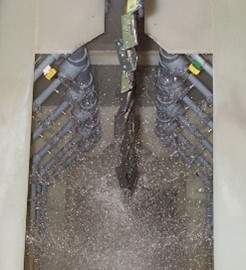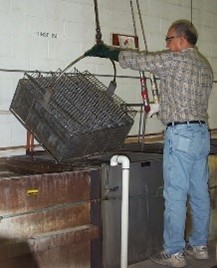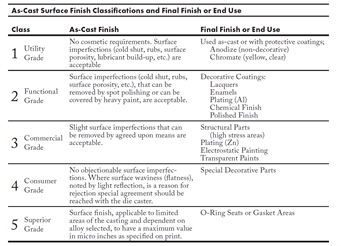
Protecting your casted investment “organically”
Surface Pretreatment and Casting Quality
Part 4 of our series about protecting your part will review the surface pretreatment process and the importance of casting quality. Both are extremely important to obtain a durable and attractive finish. Thanks to George Giering, of Giering Metal Finishing, Inc in Hamden and Waterbury, CT for providing the content for this article.
Pretreatment


Finishing metal components with a protective coating is a specialty. Having the right knowledge, chemicals and coatings are key in designing a solid finish that performs and functions for the life of the casting. Protecting die castings is especially challenging as it involves fluids & surfaces that can be tricky to successfully apply a finish. Pretreatment of the casting is one of the most important steps to achieving a durable finish.
Before a casting can be properly finished, it must be prepared. Surface preparation involves cleaning and pre-treatment of the die casting to remove the release agent, plunger tip lubricant, and machining coolant from the surface. Contaminants are known to creep inside porous cavities and boil out upon exposure to high-temperature cure cycles. Removing them completely is critical for proper coating deposition and adhesion.
At Giering, we evaluate the topography and residue of the casting to determine the best method to remove soils and condition for finishing. We develop a cleaning strategy for each product utilizing the cleaning and/or etching agents, solvent accelerators, and pH cleaners (alkaline or acidic).
The success of the pre-treatment process is measured by the finish adhesion. There are various destructive and non-destructive testing methods we use to assess the level of adhesion of the coating to determine if the pre-treatment strategy is effective. Once successful results are achieved we then create detailed process specifications to ensure repeatability in the future.
The crosshatch test is commonly used to measure the adhesion of a painted surface.
.png?width=544&name=paint%20adhesion%20tests%20(2).png)
Paint adhesion tests Closer view of Paint adhesion test
There are also mechanical methods of preparing the casted surface for finishing which is often done by the die caster. These are effective for paint adhesion as well as reducing the visibility of parting lines, heat check, lube build-up, washout, pressure marks, and flashing remnants. These casting features will telegraph thru a coating and impact decorative appearance.
Two of the most common mechanical preparations used are shot blasting and sanding, although they have different purposes. Shotblasting will remove surface lubricants and flash while texturing the surface for better finish adhesion. Sanding will remove parting lines and die check and is primarily done to enhance the decorative quality of the finished product. At General Die Casters, we utilize both a Spinner and Tumble blaster to prepare castings for a final finish.
The North American Die Casting Association classifies surface finish requirements on a 1-5 scale in the Product Specifications Standards for Die Casting. The classification can be used to facilitate discussion between the customer and die caster about the part requirements and how to best achieve them.

Coatings can also be used to mask casting flaws. Textured coatings can be used to hide surface imperfections with minimal secondary work to the casting itself. Textures help distract the eye by taking away attention from irregular surfaces or defects.
Gloss vs Flat Finish
A gloss finish will highlight defects under the surface. Casting must have an excellent finish that is free of defects if a gloss finish is used. A flat or satin finish is best used to disguise casting imperfections. A good rule of thumb is the fingernail test. If your fingernail can feel the scratch, it will show thru the coating.
Casting Quality and Finishing
A die casting’s porosity will have an impact on the quality of the final finish. High temperatures associated with drying water and curing are known to cause an expansion in air pockets trapped in castings which may result in raised bumps (blisters) in the casting itself.
If a casting is machined, the porosity, even micro-porosity, is exposed to the surface and can interfere with a quality finish. Casting impregnation, like that done at Godfrey & Wing, can help fill voids and improve corrosion performance.
Finishers have limited options for castings plagued with porosity. Castings can be prebaked at temperatures at or above the coating curing temperature to force trapped air out of the part. Anti-outgassing additives (flow agents) can be used to delay the cure speed and allow the coating to “heal” once air escapes. The last resort for salvaging castings plagued with outgassing is applying a top coat with solvent-borne liquid paint. This process can then be air-dried, or force cured at very low temperatures.
Organic finishes are an excellent way to protect and decorate your casting effectively. There are many tricks to the trade so finding an experienced source is key.
For more information on organic finishing from Giering, please visit our website at www.gieringmetalfinishing.com.
In our next article, we will learn how the anodize process and how it compares to organic coatings. Subscribe to our blog as we are now evaluating each of these processes in a salt spray test. We will determine once and for all how to best protect your die casting! Subscribe to our blog to learn more!

